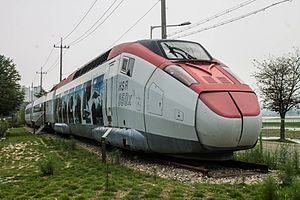| HSR-350x | |
|---|---|
 The preserved HSR-350x in Uiwang in 2015 summer. | |
| In service | 2002-2008 |
| Manufacturer | Rotem |
| Family name | KTX |
| Constructed | 1996-2002 |
| Number built | 1 |
| Number in service | 0 |
| Formation | P+M+3T+M'+P[1]
|
| Operators | KRRI |
| Depots | Osong |
| Lines served | Gyeongbu High Speed Railway |
| Specifications | |
| Car body construction | traction heads: steel[1] passenger cars: aluminum |
| Train length | 145.17 m (476 ft 3+3⁄8 in) |
| Car length | traction heads: 22.690 m (74 ft 5+1⁄4 in) powered passenger cars: 21.845 m (71 ft 8 in) unpowered passenger cars: 18.700 m (61 ft 4+1⁄4 in)[1] |
| Width | traction heads: 2.814 m (9 ft 2+3⁄4 in) passenger cars: 2.970 m (9 ft 8+7⁄8 in)[2] |
| Height | powered cars: 4.055 m (13 ft 3.6 in) unpowered passenger cars: 3.690 m (12 ft 1+1⁄4 in)[2] |
| Floor height | 1,212 mm (3 ft 11+3⁄4 in)[3] |
| Maximum speed | achieved in tests: 352.4 km/h (219.0 mph) planned in tests/design: 385 km/h (239 mph) planned in service: 350 km/h (217 mph) |
| Weight | empty: 310 t (305 long tons; 342 short tons)[1] loaded: 332 t (327 long tons; 366 short tons)[4] adhesive weight: 204 t (201 long tons; 225 short tons)[4] axle load: max. 17 t (16.7 long tons; 18.7 short tons)[2] |
| Traction system | 12 three-phase asynchronous induction motor HRTM-ILE-1100 6 IGCT-based VVVF inverters (1 per bogie)[1] |
| Power output | 12 x 1,100 kW (1,500 hp) total 13,200 kW (17,700 hp)[1][2] |
| Auxiliaries | 1.4 MW (1,900 hp)+0.7 MW (940 hp), supplying 670 V DC |
| Electric system(s) | 25 kV/60 Hz AC catenary[1] |
| Current collector(s) | pantograph (single-arm)[1] |
| UIC classification | Bo'Bo' + Bo'(2)(2)(2)(2)Bo' + Bo'Bo'[2] |
| Bogies | Jacobs bogies between intermediate cars[1] |
| Braking system(s) |
|
| Safety system(s) | TVM 430 (ATC), ATS |
| Coupling system | Scharfenberg (emergency)[6] |
| Multiple working | - |
| Track gauge | 1,435 mm (4 ft 8+1⁄2 in) standard gauge |
HSR-350x, alternatively called G7, KHST or NG-KTX, is a South Korean experimental high-speed train. It was developed and built in a joint project of government research institutes, universities and private companies that started in 1996, which aimed to reduce import dependence in high-speed rail technology. New components developed for the HSR-350x included motors, electronics, and the carbody of passenger cars. Test runs were conducted between 2002 and 2008. The experimental train achieved the South Korean rail speed record of 352.4 km/h (219.0 mph) in 2004. The HSR-350x was the basis for Korail's KTX-II (KTX-Sancheon) commercial high-speed trains.
- ^ a b c d e f g h i j k l Cite error: The named reference
rgi-kimwas invoked but never defined (see the help page). - ^ a b c d e Cite error: The named reference
krri_2003was invoked but never defined (see the help page). - ^ Cite error: The named reference
KICTEP-1was invoked but never defined (see the help page). - ^ a b Cite error: The named reference
krri_testingwas invoked but never defined (see the help page). - ^ a b "Design of On-Board Computer System for Korean High-Speed Train" (PDF). KRRI. 2000. Archived from the original (PDF) on 2011-07-22. Retrieved 2010-11-21.
- ^ "20 Front-End Modules for 10 Trains – More to Come". railway-technology.com. Net Resources International. 2007-08-03. Archived from the original on 2007-08-19. Retrieved 2010-11-19.
{{cite web}}: External link in|work=